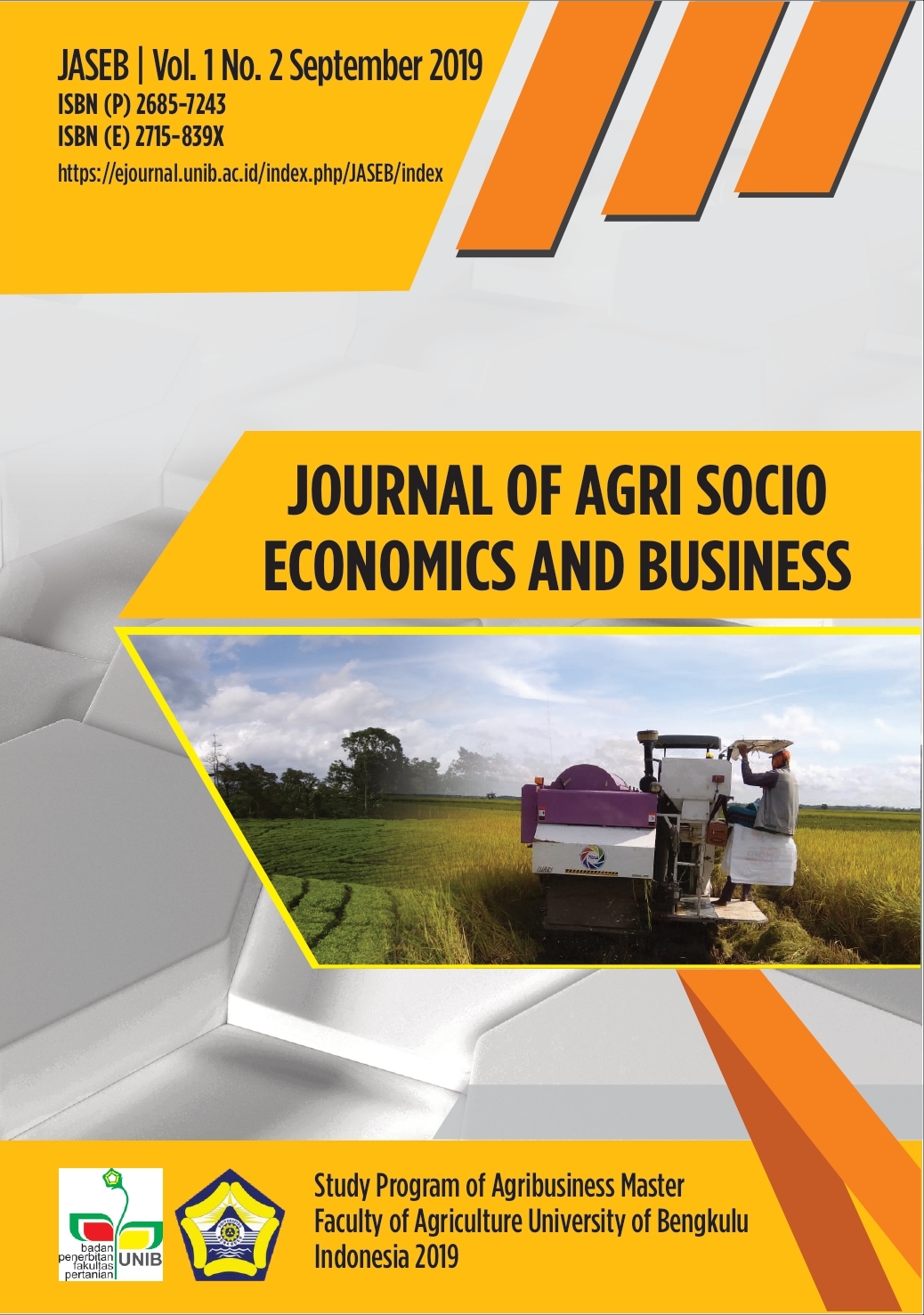Main Article Content
Abstract
In Bengkulu Province, the area of coffee plantations reached 124,510 hectares spread in several districts with production reaching 60,790.08 tons per year (BPS, 2018). Most coffee production (Coffea Spp) is produced by smallholder farmers. Nearly a quarter of the coffee production was produced by Rejang Lebong Regency, namely: 13,459 tons with a total plantation area of 27,828.12 hectares of coffee plantations. Constraints in the development of coffee are in the case of coffee marketing channels that have not been maximized by farmers, transportation due to the topography of the area and the location of the factory that is far away, low marketing production, quality of coffee (quality ), and capital that influences the selling price of the coffee. This situation is certainly inseparable from the influence of the factors of the coffee industry production itself, namely in the form of capital, raw materials, labor, transportation, marketing and income of business owners that also affect the income of workers. For this reason, researchers are interested in researching the marketing channels of Coffee in Rejang Regency. Lebong, and analyze the efficiency of the Coffee marketing channel in Rejang Lebong Regency. From the results of the study, it was found that the coffee marketing channel occurred in Rejang Lebong Regency had 5 types of marketing channels. Marketing margins and the biggest profits are obtained by large traders.
Keywords
Article Details
An author who publishes in the Journal of Agri Socio Economics and Business agrees to the following terms:
Author retains the copyright and grants the journal the right of first publication of the work simultaneously licensed under the Creative Commons Attribution-ShareAlike 4.0 License that allows others to share the work with an acknowledgement of the work's authorship and initial publication in this journal
Submission of a manuscript implies that the submitted work has not been published before (except as part of a thesis or report, or abstract); that it is not under consideration for publication elsewhere; that its publication has been approved by all co-authors. If and when the manuscript is accepted for publication, the author(s) still hold the copyright and retain publishing rights without restrictions. For the new invention, authors are suggested to manage its patent before published. The license type is CC-BY-SA 4.0.
Journal Agri Socio-Economics and Business is licensed under a Creative Commons Attribution-ShareAlike 4.0 International License.
References
- Astin Alkitasa. (2004). Margin Pemasaran, LP3ES-UI-Jakarta
- BPS Bengkulu. (2018). Rejang Lebong dalam angka. Laporan Tahunan Hutbun.
- Basu Swastha. (1999), Jenis-Jenis Pemasaran , Intimedia, Jakarta.
- Basirun dkk. (1991), Analisis Pemasaran, Bumi Aksara, Jakarta.
- Dinas Perkebunan Provinsi Bengkulu. (2015). Peluang Investasi Sub Sektor Perkebunan di Provinsi Bengkulu. Pemerintah Provinsi Bengkulu.
- Dori Suhendra. (2012), Analisis Pendapatan Usahatani Pada Kopi Tradisional dan Kopi Sambung di Desa Lubuk Kembang Kecamatan Curup Utara Kabupaten Rejang Lebong. Jurnal Agrisep.11 (1): 61-68
- Downey dan Trocke. (1981). Teori Marketing, Bina Aksara, Jakarta.
- Gittinger J.P. (1986). Analisis Ekonomi Proyek- Proyek Pertanian.Edisi Kedua. Terjemahan Universitas Indonesia Press. Jakarta.
- Halwani R.H. (2002). Ekonomi Internasional dan Globalisasi Ekonomi. Penerbit Ghalia. Indonesia. Jakarta.
- Hanafir dalam Beni (2013) http://bengkuluekspress.com/kopi-rejang-lebong-delapan-besar-se-indonesia/.
- Indrus, Muhammad. (2009). Metode penelitian Ilmu Sosial. Jakarta
- Kalaba, Yulianti. (2012). Analisis Daya Saing Kakao Indonesia. (Tesis) UGM.Yogyakarta
- Kuncoro, Mudrajat, (2009). Metode Riset untuk bisnis dan Ekonomi, Edisi 3. Jakarta,
- Kotler, Philip, et, al. (1996). Marketing Manajemen an Asian Perspective. Jakarta : Prentice Hall.
- Mubyarto, (1989). Pengantar Ekonomi Pertanian. Edisi Revisi. LP3ES. Jakarta.
- Najiyati Sri dan danarti, (1995) Kopi Budidaya dan Penanganan Lepas Panen. Penerbit PT. Penebar Swadaya
- Nasir, M.(1989). Metode Penelitian, Ghalia Indonesi, Jakarta.
- Nurlan F. (1986), Indicator Keberhasilan Dalam Pemasaran. UI-Press, Jakarta.
- Panggabean. (2011) Buku Pintar Kopi. Jakarta
- Salvatore. (1997). Ekonomi Internasional. Erlangga .Jakarta.
- Simaibang, Maruwadi (2008). Analisis Finansial Usaha tani Kopi Arabika Varietas Unggul di Kabupaten Pakpak Bharat (Kasus:Desa Kuta Mariah, Kecamatan Kerajaan, Kabupaten Pakpak Bharat).(Skripsi) USU.Medan
- Statistik Perkebunan Indonesia 2009-2011. (2013) .http://regionalinvestment.bkpm.go.id/newsipid/id/commodityarea. Php diakses terakhir 5 februari 2013
- Statistik Perkebunan Tahun 2009 -2011 (2010) Departemen Pertanian. Direktorat Jenderal Perkebunan Jakarta 2010
- Sugiono. (2012). Metode Penelitian Kuantitatif Kualitatif dan R&D . Penerbit Alfabeta Bandung
- Syamsu Alam. (2006). Kelayakan Pengembangan Kopi Sebagai Komoditas Unggulan di Provinsi Sulawesi Selatan. Univesitas Hasanudin Makasar.
References
Astin Alkitasa. (2004). Margin Pemasaran, LP3ES-UI-Jakarta
BPS Bengkulu. (2018). Rejang Lebong dalam angka. Laporan Tahunan Hutbun.
Basu Swastha. (1999), Jenis-Jenis Pemasaran , Intimedia, Jakarta.
Basirun dkk. (1991), Analisis Pemasaran, Bumi Aksara, Jakarta.
Dinas Perkebunan Provinsi Bengkulu. (2015). Peluang Investasi Sub Sektor Perkebunan di Provinsi Bengkulu. Pemerintah Provinsi Bengkulu.
Dori Suhendra. (2012), Analisis Pendapatan Usahatani Pada Kopi Tradisional dan Kopi Sambung di Desa Lubuk Kembang Kecamatan Curup Utara Kabupaten Rejang Lebong. Jurnal Agrisep.11 (1): 61-68
Downey dan Trocke. (1981). Teori Marketing, Bina Aksara, Jakarta.
Gittinger J.P. (1986). Analisis Ekonomi Proyek- Proyek Pertanian.Edisi Kedua. Terjemahan Universitas Indonesia Press. Jakarta.
Halwani R.H. (2002). Ekonomi Internasional dan Globalisasi Ekonomi. Penerbit Ghalia. Indonesia. Jakarta.
Hanafir dalam Beni (2013) http://bengkuluekspress.com/kopi-rejang-lebong-delapan-besar-se-indonesia/.
Indrus, Muhammad. (2009). Metode penelitian Ilmu Sosial. Jakarta
Kalaba, Yulianti. (2012). Analisis Daya Saing Kakao Indonesia. (Tesis) UGM.Yogyakarta
Kuncoro, Mudrajat, (2009). Metode Riset untuk bisnis dan Ekonomi, Edisi 3. Jakarta,
Kotler, Philip, et, al. (1996). Marketing Manajemen an Asian Perspective. Jakarta : Prentice Hall.
Mubyarto, (1989). Pengantar Ekonomi Pertanian. Edisi Revisi. LP3ES. Jakarta.
Najiyati Sri dan danarti, (1995) Kopi Budidaya dan Penanganan Lepas Panen. Penerbit PT. Penebar Swadaya
Nasir, M.(1989). Metode Penelitian, Ghalia Indonesi, Jakarta.
Nurlan F. (1986), Indicator Keberhasilan Dalam Pemasaran. UI-Press, Jakarta.
Panggabean. (2011) Buku Pintar Kopi. Jakarta
Salvatore. (1997). Ekonomi Internasional. Erlangga .Jakarta.
Simaibang, Maruwadi (2008). Analisis Finansial Usaha tani Kopi Arabika Varietas Unggul di Kabupaten Pakpak Bharat (Kasus:Desa Kuta Mariah, Kecamatan Kerajaan, Kabupaten Pakpak Bharat).(Skripsi) USU.Medan
Statistik Perkebunan Indonesia 2009-2011. (2013) .http://regionalinvestment.bkpm.go.id/newsipid/id/commodityarea. Php diakses terakhir 5 februari 2013
Statistik Perkebunan Tahun 2009 -2011 (2010) Departemen Pertanian. Direktorat Jenderal Perkebunan Jakarta 2010
Sugiono. (2012). Metode Penelitian Kuantitatif Kualitatif dan R&D . Penerbit Alfabeta Bandung
Syamsu Alam. (2006). Kelayakan Pengembangan Kopi Sebagai Komoditas Unggulan di Provinsi Sulawesi Selatan. Univesitas Hasanudin Makasar.
